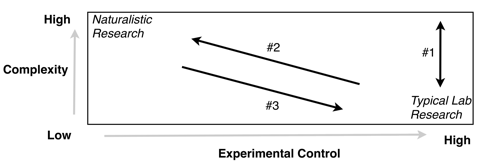Everyday Human Attention: Now You See It, Now You Don’t
Alan Kingstone
University of British Columbia
As researchers we all know that cognitive processes vary and are affected by what is happening elsewhere in the system. In other words, cognitive processes depend critically on the specific situational context in which a subject is embedded. Thus, if we wish to engage and understand the cognitive processes that are engaged by everyday living, we need to examine human performance in real life situations.

In my talk I will present different approaches (illustrated above) that researchers may take in trying to link lab with real life. One approach (see arrow #1) is to take an effect that is normally studied in an impoverished and highly controlled setting (e.g., visual search or IOR) and varying the situational complexity of the situation while maintaining high experimental control. This approach might tell us a great deal about the paradigm-specific-effect, but it probably doesn’t tell us much about the cognitive processes that are involved in everyday life; indeed, it’s very possible that the effect being studied never occurs in real-life. Another approach (arrow #2) is to increase situational complexity while loosening control. This approach is much more promising, but as I will show, one may discover in the end that the behaviour one has been studying in controlled situations occurs because of that control. A third approach (arrow #3), called cognitive ethology, initially observes naturally occurring behaviour, and then progressively introduces experimental control. One major advantage of this approach is that one can discover immediately whether the naturally occurring effect does (or does not) persist when it is introduced into a controlled setting in the lab; and therefore one can discover whether the effect one is studying in the lab is likely (or not) to provide information about behaviour that really occurs in everyday life.